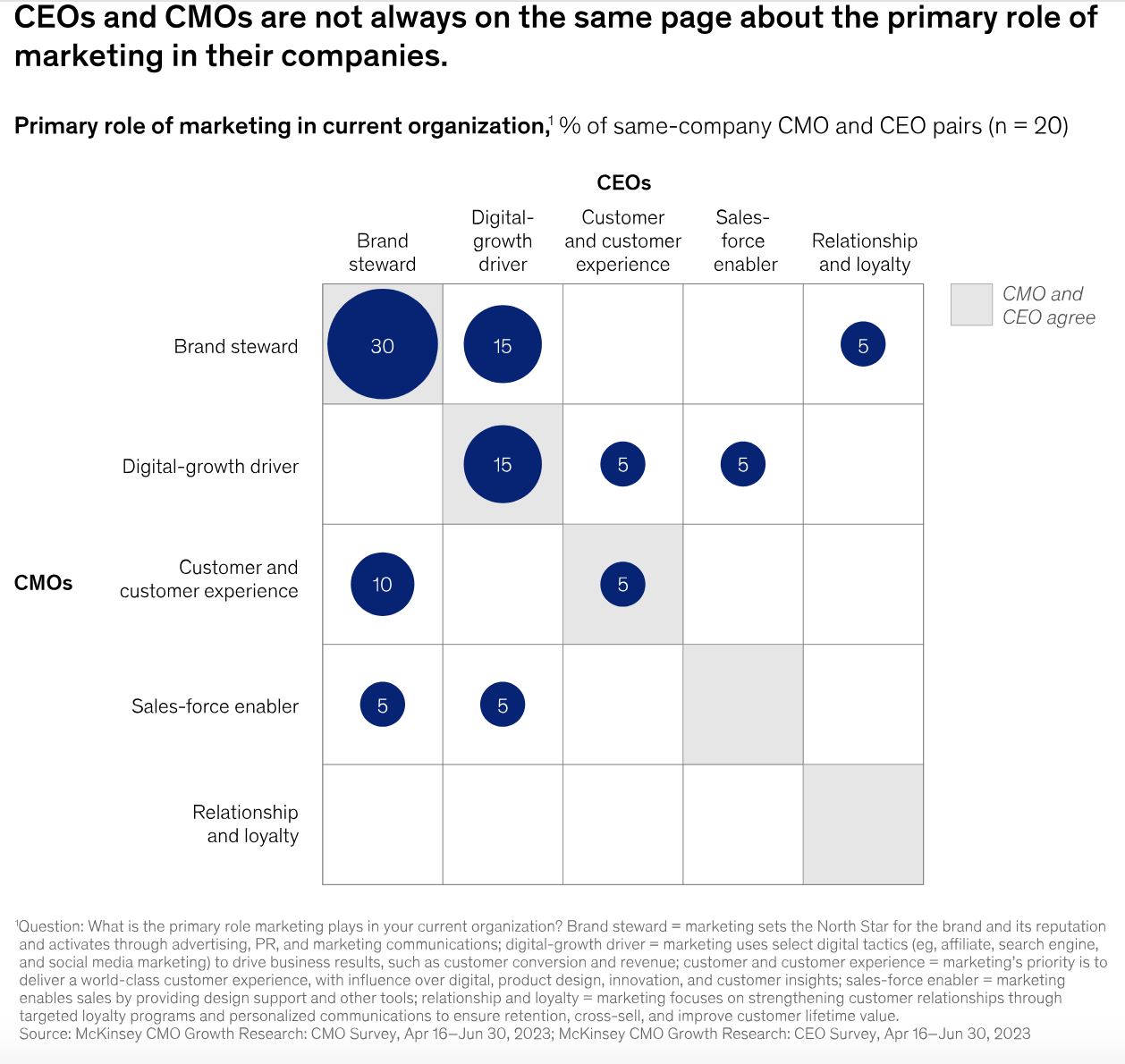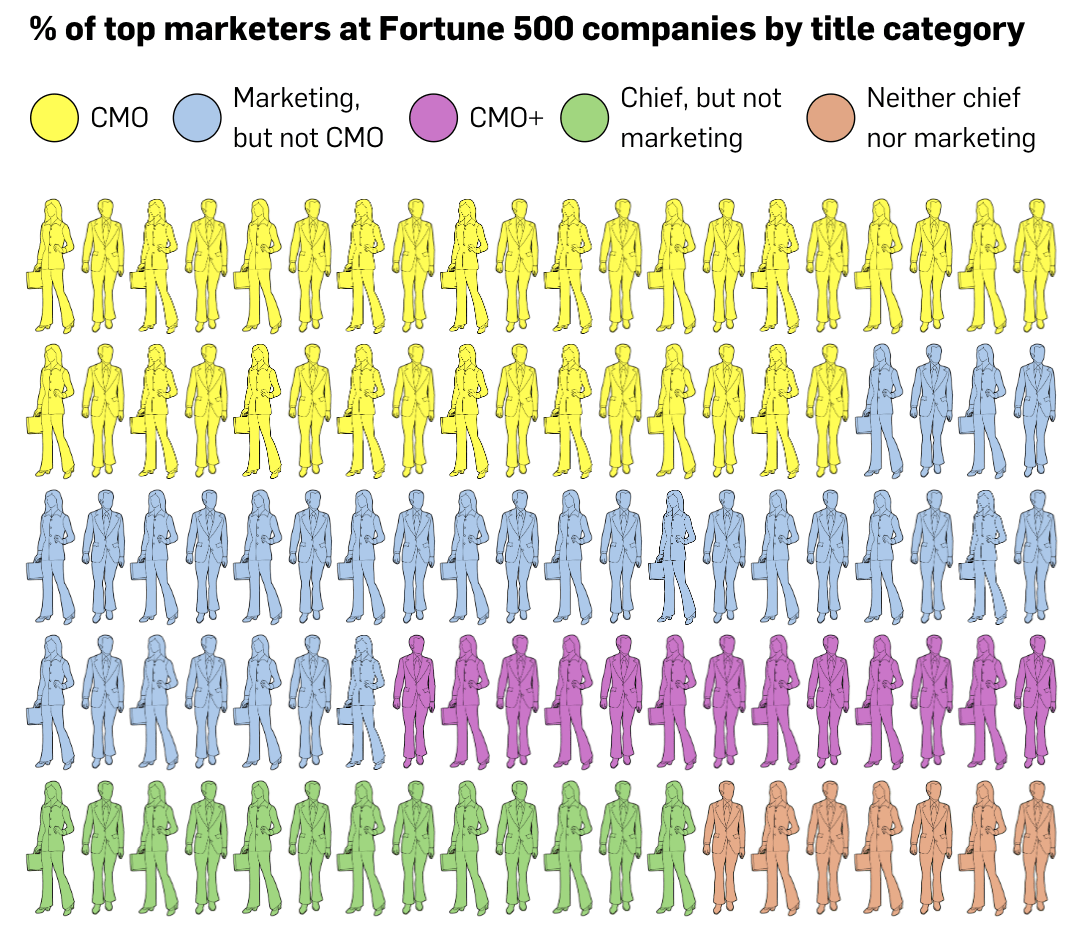What do Starbucks, Uber, Lyft, and UPS have in common? They’ve all eliminated the chief marketing officer (CMO) role.
At face value, it may seem like these companies are shifting their focus away from marketing to different aspects of the business. But that’s not entirely the case. Instead, these brands are reconfiguring the C-suite in new ways to answer the needs of modern marketing.
When marketing was still about traditional advertising like print and TV, it made sense to have one leader call all the shots. But digital marketing today encompasses a more complex set of challenges–and companies need to redefine the CMO role to fit the new marketing playbook.
How the role of the CMO has changed
As the pace of change in marketing has picked up over the last few years, the role of the CMO has become less clearly defined at many businesses. CEOs and CMOs aren’t always on the same page about what marketing does for their businesses. According to a survey by McKinsey, only half of CMO-CEO pairings at the same company gave the same answer when asked what the primary role of marketing is.
Without agreement among executives on overall goals, it can be hard for CMOs and their teams to effectively carry out marketing strategy. That puts additional pressure on these roles and makes it hard for them to get buy-in for their initiatives. The average CMO tenure lasts just 24 months–and that misalignment in the C-suite is likely at least partly to blame.

Source: McKinsey
Different aspects of a brand’s business will also impact marketing outcomes, especially now. The overall customer experience has become an increasingly important part of the purchase journey as audiences seek out brands with more personalized and targeted marketing.
Even for companies that still have a traditional CMO, marketing is often becoming a more holistic effort, with CEOs giving responsibilities for customers to strategy or operational leaders as well.
These days, it’s not enough for a leader looking to drive business growth to understand the fundamentals of marketing alone; they need to know what consumers want and how to make the customer’s overall experience of the brand as frictionless as possible. That means many execs need to branch out and get more involved in decisions that aren’t traditionally considered part of the marketing purview.
Changing titles, dividing responsibilities: the future of the CMO is still being written
For many major companies, that means they’re not just redefining the CMO role, they’re retitling it or shifting some of those traditional responsibilities across more roles. According to data from Spencer Stuart, only 36% of top marketers at Fortune 500 companies currently hold the traditional CMO title. So if CMOs are on the way out at some businesses, how are companies replacing them?
Some businesses are choosing to combine multiple roles to fill the slot once held by CMOs alone, while others are changing the way they hire altogether.

Source: Adweek
A significant number of businesses are making marketing leadership more collaborative. In a partnership with the Association of National Advertisers, McKinsey found that more than two-thirds of CMOs said that two or more C-suite leaders oversee marketing-related activities.
Several important businesses have changed their CMO roles in recent years: Starbucks has shifted from a CMO to regional CEOs pursuing a more localized strategy, promoting their previous CMO to CEO over international business. Ride-share companies Lyft, which separated its CMO title into two VP roles, and Uber, which replaced its CMO with a VP, are also looking for ways to cater to more modern marketing sensibilities.
Spencer Stuart found that many top marketers at Fortune 500 companies don’t have marketing in their title at all. Some of the C-suite leaders who take marketing responsibilities instead of CMOs include chief revenue officers, chief growth officers, and chief creative officers. UPS replaced its CMO with a chief commercial and strategy officer who oversees product management and business transformation.
Today’s CMO: how marketing leaders are changing the role
Despite changes to the role, many companies are still leaning into the traditional CMO model. To succeed with a CMO, businesses need to update the way the C-suite operates to fit today’s marketing landscape.
To start with, it’s essential for everyone in the C-suite to have a good understanding of what makes marketing work. Executives tend to have an overly optimistic outlook on what marketing can achieve and how quickly it can achieve it, which means CMOs are sometimes set up to fail when they can’t meet those high expectations. Part of that is because some of the most essential parts of marketing strategy, like brand-building, aren’t as easily quantified as other markers of business success.
CMOs must clearly define their responsibilities and scope before they get started. They need to set up the right KPIs and metrics to make a clear picture of what success looks like when it comes to marketing, including “soft” metrics like brand likeability. If execs fail to clarify these expectations from the outset, they risk being held responsible for any downturn–even when it’s out of marketing’s control.
It’s also important for the C-suite to build trust in their relationship with their CMO. Boathouse found that only 20% of CEOs felt that the CMO was on their side while 10% felt the CMO put their needs before their own. That doubt makes it hard for executives to work together and prioritize marketing in their budget and strategy in the long term.
Fractional CMOs: short-term tenures are on the rise
Some businesses have jumped on another growing trend: the fractional CMO. Like consultants or freelancers, these employees come with a lower time and cost commitment; their tenure typically lasts 3-9 months at a company. But unlike consultants or freelancers, a fractional CMO has a high level of accountability and responsibility for deliverables.
With a fractional CMO, you can get short-term help on a specific area your brand is looking to improve. Need to overhaul the customer experience? Looking to drive growth and increase revenue? You can find an interim CMO who has the background you’re looking for to lead the charge.
An “on-demand” CMO can fill gaps if your regular team is missing some capabilities. Since they’re not full employees, they can distribute and delegate certain tasks without getting caught up in day-to-day C-Suite decisions. However, they may also lack some of the commitment and depth of understanding that a long-term executive might have.
As modern marketing becomes more complex, it makes sense that the CMO role would evolve to fit today’s marketing climate—even if that means splitting the role between multiple people or having a rotating door of fractional CMOs. This is far from the “death of the CMO.” The trend of bucking the CMO in favor of a “non-traditional” role is merely the next step in the evolution of the marketing industry at large.
Regardless of title or organizational structure, the responsibilities of the CMO aren’t going anywhere. In fact, as marketing’s purview expands to encompass more of the overall customer experience, it’s more essential than ever to have the right model of marketing leadership to help your brand succeed.







Responses